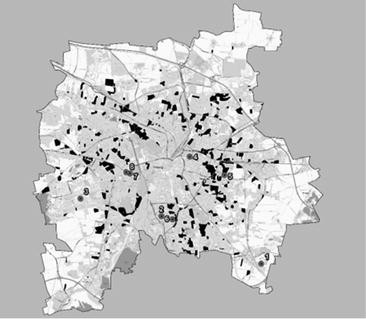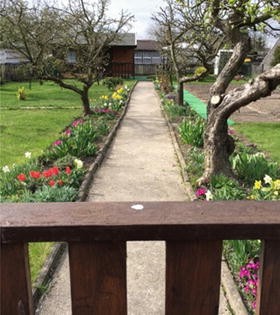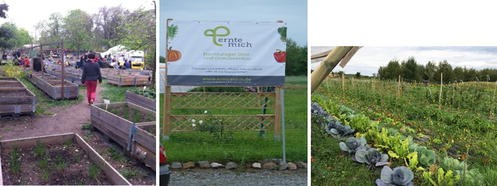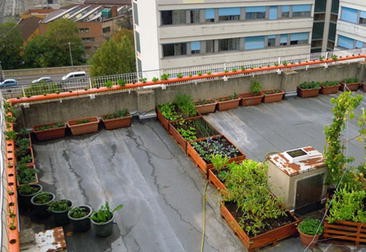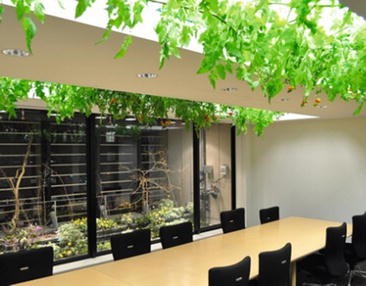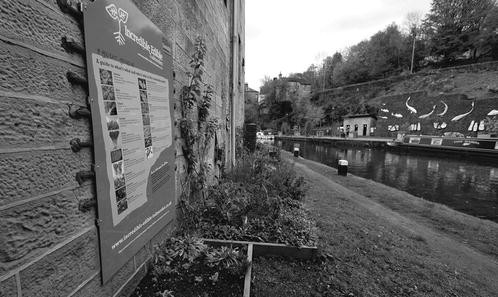Urban Gardens as Multifunctional Nature-Based Solutions for Societal Goals in a Changing Climate
Abstract
Urban gardens can contribute to climate mitigation and adaptation through a range of provisioning, regulating, and cultural ecosystem services as multifunctional nature-based solutions in a city. Besides providing food, urban gardens contribute to water regulation through unsealed soils, to improved air circulation and cooling through plant transpiration and shading, offering microclimate oases to many users, such as gardeners, visitors, and immediate neighbors. In combination with other green and blue infrastructures, urban gardens can thereby help to mitigate and adapt to the urban heat island effect. They also provide important habitat for wildlife and genetic diversity. Urban gardens create opportunities for leisure and recreation and thereby promote health and well-being, as well as a sense of place, cultural identity, and social cohesion – important factors for societies to adapt to change. Exploring case studies across Europe, we discuss differences between garden types and their contribution to achieving sustainability goals for city communities.
Keywords
Urban gardens Community gardens Allotment gardens Climate change adaptation and mitigation Ecosystem services Climate change and food security Nature-based solutions14.1 Introduction
Climate change involves complex environmental, political, and socio economic interactions that cannot be addressed in isolation of holistic societal and human well-being concerns, including social cohesion, equity, and social justice interests (IPPC 2001; Adger and Barnett 2009; Haase, Chap. 13, Kabisch et al., Chap. 12 and Braubach et al., Chap. 11, this volume). With a changing climate, policy makers and advisors face challenges on how to mitigate and adapt while taking into consideration societal goals. One of the ways to deal with societal goals in the context of climate change is through nature-based solutions, including a wide range of green and blue infrastructure measures.
This chapter focuses on urban gardens, particularly allotments and community gardens, as one type of green infrastructure. Allotment gardens are mostly larger estates divided into plots that are allocated under rental payments to a single person or a family for non commercial cultivation of fruits, vegetables, and ornamental plants and recreational purposes. They are normally ruled and managed by local authorities, associations, or private or public organizations. In contrast, community gardens are single pieces of land that are gardened and managed collectively by a group of people. Community gardens, may have a permanent or temporary character, and are often characterized by informal claiming of urban voids with the purpose of local community development (Adams et al. 2013).
In this chapter, we explore how allotment and community gardens can serve as multifunctional nature-based solutions to achieve both climate-related and societal goals. Throughout the chapter, case studies illustrate how ecosystem services are provided by urban gardens in cities such as Lisbon, Leipzig, Manchester, and Poznan, all set in different socio-ecological contexts across Europe from northern to southern regions and from eastern to western regions. We first outline a brief history of urban gardens, then reflect on similarities and differences of the case studies, and discuss the multi functional dimensions of urban gardens from provision of genetic diversity, places for recreation promoting human well-being to drivers for social cohesion in a changing climate. In conclusion, we present prospects for the future of urban gardens in Europe.
14.2 History of Urban Gardens
Urban gardens have played an important role in cities ever since cities exist (Bell and Fox-Kämper 2016). The first European allotment garden was located in Kappeln, Germany, and dates back to 1814. The allotment garden movement became prominent after 1861, when the first allotment association in Leipzig was created by the Schrebergarten movement, spreading subsequently across central Europe in the next century.
Historically, the primary goal of allotment gardens was to mitigate poverty among factory workers during the industrial revolution by providing food. Another specific goal, at least by Dr. Schreber, was to provide opportunities for recreation, especially for children. As such, societal goals are imminently entwined with allotments. In fact, most allotments in Central and Northern Europe provide playgrounds in the common areas and often have a clubhouse for cultural events (Cabral and Weiland 2016), promoting recreation and social cohesion. Today, the Office International du Coin de Terre et des Jardins familiaux (http://jardins-familiaux.org/) accounts for two million allotment gardens across Europe.
During the First and Second World Wars, England, (Speak et al. 2015), Germany and Sweden (Barthel et al. 2010) relied on allotment gardens to provide 10% of each country’s food needs. During the 1970s oil crisis, European allotments proved to be equally important, mitigating unemployment and austerity and acting as a reliable way of producing food (Adam-Bradford and Veenhuizen 2016). In fact, the recent economic and financial recession in Southern European countries has caused a resurgence of urban gardens, e.g., in Spain during the 2000s (Camps-Calvet et al. 2015), Portugal after 2000, and later in Greece in 2010, to address issues of food security as well as climate change through a greater emphasis on self-sufficiency. The rise of urban gardens and other urban agriculture initiatives is also associated with a desire to reduce food miles, another avenue to contribute to reduced carbon emissions and climate mitigation in cities. The renewed interest in urban gardens prompted a European research action to assess challenges and opportunities posed by these spaces (COST action TU1201; Bell et al. 2016; Box 14.1).
Box 14.1: European Urban Gardens
The COST Action TU1201 (http://www.urbanallotments.eu) is a research network involving 31 European countries and New Zealand as a partner country, bringing together experts from various fields established in academia, municipalities, and urban gardening associations. To understand the contribution of allotment and community gardens in Europe in achieving urban sustainability with regard to social and ecological aspects, and economic resilience in a changing future, and their role in urban design and urban policy, the research consortium explored extensive case studies (Bell et al. 2016).
Allotment and community gardens vary across Europe in terms of historical, cultural, political, and planning contexts from well-established institutions in Northern European countries to rather recent developments in Southern Europe. Access to such spaces may be prevented by pressures for urban development, the lack of maintenance or investment in existing and new sites, as well as difficulties in contractual arrangements. Consequently, new community urban gardens are a response to the inadequacy of conventional schemes, imbalance between demand and offer, and slow adaptation of the planning systems to the recent socio economic and political crises and changes (Caputo et al. 2016). They are also an expression of group manifestations, green activism, or similar socio political engagements (Shepard 2013; Hardman and Larkham 2014) and entrepreneurship. Situated in specific urban and social contexts (Ioannou et al. 2016), emergent community gardens tend to be absent of rigid capacity, allow for temporary occupation and mobility, and enable new urban socio-spatial experimentations and practices, thus transcending the conventional concept of allotment (Caputo et al. 2016).
The diversity of urban gardens therefore offers significant opportunities to meet different societal and urban challenges through providing ecosystem services in proximity with neighborhoods as part of the cities’ green infrastructure in a changing climate.
Spatially, allotment gardens are distributed across all Europe with a focus in Central and Northern Europe (Bell et al. 2016). Allotments are commonly found along train tracks, water canals, or adjacent to previous industrial areas, as these were formerly marginal lands (now often protected through city planning laws for their noise and flood risk). Today, European allotments are under threat in several cities (such as Warsaw, Poznan, Basel, Riga, and Vienna) due to real estate pressure (Costa et al. 2016). In Southern Europe, however, they have been growing in number and size as part of several city planning strategies.
Community gardens provide another form of gardening spreading in Europe for the last 20 years as a complement to allotment gardens. Community gardens are filling urban voids, by squatting within brownfields in large- and medium-sized cities. These are usually initiatives of younger gardeners, who use these spaces mostly for social purposes, such as recreation, education, physical and mental health services (Genter et al. 2015; Wood et al. 2015), and thus for social cohesion.
The history of community gardens is quite recent and followed a New York trend during the financial crisis of 1970. In Europe, this form of gardening has been intertwined with the guerrilla gardening and transition town movements. While this form of gardening is at times based on illegal occupation or squatting, in some cities it has become legal for interim use. There are several examples of municipalities and local governments that encourage the creation of community gardens (also known as guerrilla, intercultural, or neighborhood gardens). Some of them are Barcelona (Langemeyer 2015), Milan (Silvestri 2014), Athens (Anthopoulou 2012), Berlin (Appel et al. 2011), and Leipzig (Weiland 2015). These gardens represent a new social movement aiming to augment resilience in socio-ecological systems (Ioannou et al. 2016).
14.3 Urban Gardens Across Europe: The Importance of Socio economic Context and Urban Planning
The case studies in this chapter illustrate the main trends in Europe with regard to urban gardens as nature-based solution for urban integration, municipal policy, and ecosystem services, with Leipzig and Lisbon representing northern and southern geophysical and urban planning-related differences. Leipzig has a long tradition of allotment gardens (Box 14.2) and a large number of successful and legal community gardens, the oldest being 20 years old. These community gardens promote environmental education as well as for social cohesion (Box 14.3) and therefore are important contributing factors in cities for climate adaptation. Lisbon, on the other hand, has a very recent, yet successful, history of allotment gardens (Box 14.4). It has, however, few community gardens, due to restrictive policies by the city (e.g., former community garden Horta do Monte, Graça). While in Leipzig accessibility is restricted in allotment sites located on private land and this law is enforced by the allotment club (especially during winter time), allotments located on municipal land are enforced to open their common areas, i.e., playgrounds and restaurants, to the public, during spring and summer time. In Lisbon, the strategy for promoting recreation in allotments has led to the integration of these spaces into existing urban parks to create ecological corridors (Cabral and Weiland 2016), although this has incurred some privacy loss and some acts of vandalism.
Box 14.2: Urban Gardens in Leipzig: A Long History of Allotment Gardening
Map of Leipzig allotment gardens (in black ) and community gardens (numbered 1-8) (Credit: Roland Kraemer, UFZ/iDiv)
Kleingarten Naturfreunde (Credit: Cabral)
Box 14.3: Community Garden Initiatives in Leipzig: Interplay of Spatial Policy and Cultural Context as Impulse for Social Innovation
Community gardens : Annalinde (Credit: Cabral) and community-supported agriculture, start-up “ernte mich” (Credit: Cabral and Weiland)
This interplay of space availability and cultural movement therefore provides opportunities for social innovation to grow and as an experimental space to explore ecological alternatives (Müller and Überall 2014) under global change.
Box 14.4: Urban Gardens in Lisbon: Providing Food and Occupational Activities
Vale de Chelas Horticultural park (credit: Costa)
14.4 Urban Gardens as Banks of Genetic Diversity
Urban gardens can promote habitat for diverse plant species, both ornamental species and cultivated species, while these can sometimes include non native and invasive species (Smith et al. 2006; Bigirimana et al. 2012; Jaganmohan et al. 2012) which may spread with a changing climate. However, recent studies have shown that allotments in Poznan and Manchester can host many native species, especially when many plots are abandoned (Speak et al. 2015; Borysiak et al. 2017, Box 14.5), a result we could also show for Leipzig (Cabral et al. 2017).
Box 14.5: Urban Gardens in Manchester and Poznan: Provision of Habitats for Biodiversity and Ecosystem Services
Speak et al. (2015) compared the biodiversity and ecosystem services provided by allotments in Poznan (Poland) and Manchester (UK). Together with another study by Borysiak et al. (2017), on 11 representative allotment estates in Poznan, 357 spontaneous species were found, among which 72% were native. This is probably due to the fact that some allotment estates can host a high number of spontaneous plants which is correlated with a high number of abandoned plots. Thus the authors could show that allotments make a significant contribution to biodiversity conservation unlike many previous studies have documented.
The authors also found remarkable differences in ecosystem service provision between sites and between countries. While in Poznan the plots are large and host large trees, which contribute to (micro)climate regulation, Manchester allotments have fewer trees since they allocate more space to food cultivation, while recreational use also differs, responding to societal preferences and possibly socio economic needs. Their study also shows that urban gardens can serve a multitude of purposes and may – especially at the individual gardener level – serve as adaptation potential to respond to changing climate and urbanization pressure.
Since many landrace cultivars in Europe, i.e., traditional crop varieties adapted to a specific geographical area, are threatened by extinction as they have often been substituted by commercial strains, some authors argue that the maintenance of these landraces in urban gardens can convert these spaces into a gene banks (Barthel et al. 2010, 2013). In this way, urban gardens can make a significant contribution to climate change adaptation, as these varieties are more likely to adapt to changing and extreme conditions and may therefore contribute to resilience in an urban environment.
14.5 Urban Gardens as Places for Promotion of Health and Human Well-Being
Allotment gardens can make significant contributions to human health and well-being, with main benefits arising from the contact with nature and the social opportunities provided by such places, which thus provide a stress-relieving refuge, enable self-development, and contribute to healthier lifestyles (Genter et al. 2015). There is a general understanding of the perceived benefits for health promotion arising from engaging in community garden activities (Armstrong 2000). Hawkins et al. (2011) found lower levels of stress among gardeners, ages 50–88, than their peers who performed indoor exercises. Part of the benefits seem to arise from the activity of gardening itself. Van Den Berg and Custers (2011) found that gardening can promote relief from acute stress. In their study, allotment gardeners were submitted to a stressful Stroop task and then assigned to 30 min of outdoor gardening while measuring salivary cortisol levels and self-reported mood; decrease in salivary cortisol and thus levels of stress and positive moods were fully restored after gardening. Another study in the UK, comparing the mental well-being of allotment gardeners with non-gardeners, found that the allotment gardeners’ self-esteem, mood, and general health were significantly improved as a result of just one allotment session (Wood et al. 2015). These studies begin to demonstrate not only the perceived impact of allotments and community gardens in health and well-being but also its actual impact. Understanding the significance of the contribution of urban gardens as a nature-based solution toward well-being is opportune in the current context, where there is an increasing political interest in public health, in well-being agendas, and in the impacts of the environment on mental and physical health.
14.6 Urban Gardens as Drivers for Social Cohesion
One of the characteristics that can be studied regarding allotments and community gardens is their social relevance for the people involved but also for the surrounding communities. Adaptation to change (e.g., to climate change) is always a challenge which depends on individual and community knowledge, attitudes to risk, and cultural predisposition (Adger et al. 2009), among other factors. Urban gardens can help build social capacity to implement change (Adger 2003; Smit and Wandel 2006) by providing environmental education, intergenerational learning, and understanding of natural processes, cycles, and processes of climate change itself. According to Barthel and Isendahl (2013), they have the capacity to respond to needs of socio-ecological resilience. Firth et al. (2011) have shown that the social benefits associated with community gardens are broad and include increasing social cohesion and the ability of sharing common values, aims and behaviors, social support, and social connections developed through social bonds and networks. There are many examples of collective action (Adger 2003) around the creation of community gardens to increase resilience in communities. Thus, these have the ability to increase resilience and adaptive capacity of social structures (Folke et al. 2002) in times of change and crises (e.g., producing fresh food for self-consumption and for local communities) and to provide a place for socialization.
While the importance of urban gardening is recognized as a driver for community building and social cohesion, the ways in which it happens may not always be immediate and direct (Rodrigues et al. in review). In the early stages of development, such benefits do not necessarily lengthen beyond the site and the people involved to the realms of the neighborhood or the city (Veen 2015; Firth et al. 2011). Moreover, the integration of community gardens within existing social structures and in bringing together people from different socio economic backgrounds may face some challenges (Veen 2015). However, social relations in gardens which have a main focus on the social benefits of gardening have larger effects beyond the garden itself (Veen 2015).
In contexts of migrant and refugee communities flows, urban gardens have the potential to integrate diverse ethnic and social groups, and even though there might be vulnerable issues to solve through the process of engagement development, there are good examples of how these promote social integration and cohesion. For example, community gardens in Glasgow cultivate collective practices that promote an “equality-of-participation in place and community making,” accentuating relations between people, organizational processes, and institutions and the opportunity to develop and use public spaces in Glasgow (Crossan et al. 2016). Community gardens enable better social networks and organizational capacity within the communities they are located, but this appears to be further enhanced in lower income and minority neighborhoods (Armstrong 2000). Due to climate change, natural catastrophes can lead to migration movements more often. Since urban gardens can promote integration in societies and promote knowledge exchange and cultural tolerance, they can ultimately avoid social instability during crisis and distressful situations and serve as models and tools to adapt to climate change.
14.7 Future Opportunities for Urban Gardening
Rooftop garden in Bologna (Credit: Orsini)
Indoor farm at Pasona’s Tokyo building (Credit: De Zeen)
But gardening in buildings can do more than just provide food. Roof gardens, for example, can also contribute to climate and water regulating services by offsetting the effects of hard surfaces and impervious surfaces caused by buildings. In fact, shading a roof surface can lower its temperature, and soil beds can absorb rainwater, reducing surface run off (see also Enzi et al., Chap. 10, this volume). Additionally, roof gardens’ soil beds reinforce the thermal insulation of a building rooftop, leading to lower energy consumption and thus lower carbon emissions. There is also another advantage in gardening in an elevated site: a rooftop has potentially more solar exposure within a city than a ground located garden, thus enhancing plant growth.
From a social perspective, gardening on a common area such as a residential building rooftop, if shared by tenants, provides an opportunity for meeting neighbors and sharing knowledge on gardening. From an ecological perspective, rooftops can attract pollinators and birds and create a more biodiverse ecosystem in the city skyline (Orsini et al. 2014).
Box 14.6: The Incredible Edible Project: a Community Movement Turned into an International Reference
The green route map and a vegetable patch along the canal in Todmorden (Credit: Paull 2013)
Within public spaces such as parks, and pedestrian streets, promoting edible species can become a source of food with financial advantages for both the municipality and its citizens. In fact, some cities have implemented this goal successfully, such as in the case of Berlin and Leipzig (Essbare Stadt project) or Hague (Urbania Hoeve) where both municipalities provide maps containing edible trees for free harvesting. At an even bigger scale, the city of Munich has transformed in 2005 a former airport into an exhibition area, called Die Plantage, which contains mostly edible species (Philips 2013). In a remarkable case, the city of Todmorden (Box 14.6) has seen a guerrilla gardening movement turn the whole city into an edible garden, as citizens took up the task of planting edible species in every empty space in the city. Todmorden has become a popular reference after establishing the incredible edible network which extends now to hundreds of cities in Europe and around the world (Paull 2013).
14.8 Conclusions
Allotments and community gardens are not the largest contributors for climate mitigation at the city level, as parks and private gardens can contribute more due to larger amounts of biomass in large trees. Their role in microclimate regulation is heightened when gardens are interlinked with other green spaces, thus enhancing their performance. Additionally, they play important roles for water regulation in providing unsealed surfaces for regulating run off and providing open space to escape the urban heat island. They also provide habitat for native flora and may serve as gene banks for adapted land cultivars. Furthermore, they are important societal meeting places that can contribute to recreation, health, and well-being as well as social cohesion.
New urban gardens, or community gardens, are a response to the current needs, not only for food provision but also for socio political expressions and manifestations. Grassroots movements have proven that gardening is an important cultural contribution for future generations and that the future of cities needs to address this demand by providing more space and more autonomy for better governance. The densification of urban environments necessitates the use of innovative nature-based solutions that respond and adapt to physical, socio economic challenges and embrace new and creative typologies of spaces and approaches of urban gardening that can be undertaken, for example, in existing or new developed buildings. These are all important factors to facilitate climate change adaptation in urban communities.
References
- Adam-Bradford A, van Veenhuizen R (2016) Role of urban agriculture in disasters and emergencies. In: de Zeeuw H, Drechsel P (eds) Cities and agriculture: developing resilient urban food systems. Routledge, Oxon, pp 387–410Google Scholar
- Adams D, Scott AJ, Hardman M (2013) Guerrilla warfare in the planning system: revolution or progress towards sustainability? Geogr Ann 95(4):375–387CrossRefGoogle Scholar
- Adger WN (2003) Social capital, collective action, and adaptation to climate change. Econ Geogr 79:387–404CrossRefGoogle Scholar
- Adger WN, Barnett J (2009) Four reasons for concern about adaptation to climate change. Environ Plan A 41:2800–2805CrossRefGoogle Scholar
- Adger WN, Dessai S, Goulden M (2009) Are there social limits to adaptation to climate change. Climat Change 93(3):335–354CrossRefGoogle Scholar
- Anthopoulou T (2012) Urban agriculture. Social inclusion and sustainable city. Case study of two municipal gardens in northern Greece. Panteion University, Athens. (research report in greek)Google Scholar
- Appel I, Grebe C, Spitthoever M (2011) Aktuelle Gartenitinitiaven. Kleingärten und neue Gärten in deutschen Großstädten. [Recent gardening initiatives: allotments and new gardens in big german cities]. Kassel University Press, KasselGoogle Scholar
- Armstrong D (2000) A survey of community gardens in upstate New York: implications for health promotion and community development. Health & Place 6:319–327CrossRefGoogle Scholar
- Barthel S, Folke C, Colding J (2010) Socio-ecological memory in urban gardens -retaining the capacity for management of ecosystem services. Glob Environ Chang 20(2):255–265CrossRefGoogle Scholar
- Barthel S, Isendahl C (2013) Urban gardens, agriculture and water management: sources of resilience for long term food security in cities. Ecol Econ 86(224):234Google Scholar
- Bell S, Fox-Kämper R (2016) A history of urban gardens in Europe. In: Bell S et al (eds) Urban allotment gardens in Europe. Routledge, London/New York, pp 8–32Google Scholar
- Bell S, Fox-Kämper R, Keshavarz N, Benson M, Caputo S, Noori S, Voigt A (2016) Urban allotment gardens in Europe. Routledge, London/New YorkGoogle Scholar
- Bigirimana J, Bogaert J, De Cannière C, Bigendako M-J, Parmentier I (2012) Domestic garden plant diversity in Bujumbura, Burundi: role of the socio-economical status of the neighborhood and alien species invasion risk. Landsc Urban Plan 107:118–126CrossRefGoogle Scholar
- Borysiak J, Mizgajski A, Speak A (2017) Floral biodiversity of allotment gardens and its contribution to urban green infrastructure. Urban Ecosys. 20:323–335CrossRefGoogle Scholar
- Cabral I, Weiland U (2016) Urban gardening in Lisbon and Leipzig: a comparative study on governance. TU1201. In: Tappert, S., Drilling, M. (eds) (2016): Growing in Cities. Interdisciplinary Perspectives on Urban Gardening. Conference Proceedings. Basel: University of Applied Sciences: 66-79. Available on http://www.sozialestadtentwicklung.ch/tagungen/growing_cities.pdf
- Cabral I, Keim J, Engelmann R, Kraemer R, Siebert J, Bonn A (2017) Assessing ecosystem services of allotments and community gardens: a Leipzig, Germany case study. Urban Urban Green 23(4):44–53CrossRefGoogle Scholar
- Camps-Calvet M, Langemeyer J, Calvet-Mir L, Gómez-Baggethun E, March H (2015) Sowing resilience and contestation in times of crises: the case of urban gardening movements in Barcelona. Partecipazione e Conflitto 8(2):417–442Google Scholar
- Caputo S, Schwab E, Tsiambaos K, Benson M, Bonnavaud H, Demircan N, Pourias J (2016) Emergent approaches to urban gardening. In: Bell S et al (eds) Urban allotment gardens in Europe. Routledge, London/New York, pp 229–253Google Scholar
- Costa S, Fox-Kamper R, Good R, Sentic I (2016) The position of urban allotment gardens within the urban fabric. In: Bell S et al (eds) Urban allotment gardens in Europe. Routledge, London/New York, pp 201–228Google Scholar
- Crossan J, Cumbers A, McMaster R, Shaw D (2016) Contesting neoliberal urbanism in Glasgow’s community gardens: the practice of DIY citizenship. Antipode 48:937–955CrossRefGoogle Scholar
- Firth C, Maye D, Pearson D (2011) Developing “community” in community gardens. Local Environ 16(6):555–568CrossRefGoogle Scholar
- Folke C, Carpenter S, Emqvist T, Gunderson L, Holling CS, Walker B (2002) Resilience and sustainable development: building adaptive capacity in a world of transformations. Ambio 31:437–440CrossRefGoogle Scholar
- Genter C, Roberts A, Richardson J, Sheaff M (2015) The contribution of allotment gardening to health and wellbeing: a systematic review of the literature. Br J Occup Ther 78(10):593–605CrossRefGoogle Scholar
- Haase A, Rink D, Grossmann K, Bernt M, Mykhenko V (2014) Conceptualizing urban shrinkage. Environ Plann A46 7:1519–1534CrossRefGoogle Scholar
- Hardman M, Larkham PJ (2014) Informal urban agriculture: the secret lives of Guerrilla gardeners. Springer, ChamCrossRefGoogle Scholar
- Hawkins JL, Thirlaway KJ, Back K, Clayton DA (2011) Allotment gardening and other leisure activities for stress reduction and healthy ageing. Hort Technol 21(5):577–585Google Scholar
- Ioannou B, Morán N, Sondermann M, Certomà C, Hardman M (2016) Grassroots gardening movements. In: Bell S et al (eds) Urban allotment gardens in Europe. Routledge, London/New York, pp 62–90Google Scholar
- IPCC (2001) In: Metz B, Davidson O, Swart R, Pan J (eds) Climate Change 2001: mitigation – contribution of Working Group III to the third assessment report of the Intergovernmental Panel on Climate Change (IPCC). Cambridge University Press, CambridgeGoogle Scholar
- Jaganmohan M, Vailshery LS, Gopal D, Nagendra H (2012) Plant diversity and distribution in urban domestic gardens and apartments in Bangalore, India. Urban Ecosyst 15:911–925CrossRefGoogle Scholar
- Langemeyer J (2015) Urban ecosystem services: the value of green spaces in cities. PhD thesis, Stockholm UniversityGoogle Scholar
- Müller C, Überall D (2014) Urban gardening Manifest. Die Stadt ist unser Garten-Manifest. Available at http://www.urbangardeningmanifest.de. Accessed 25 Sept 2016
- Orsini F, Gasperi D, Marchetti L, Piovene C, Draghetti S, Ramazzotti S, Bazzocchi G, Gianquinto G (2014) Exploring the production capacity of rooftop gardens (RTGs) in urban agriculture: the potential impact on food and nutrition security, biodiversity and other ecosystem services in the city of Bologna. Food Secur 6:781–792CrossRefGoogle Scholar
- Paull J (2013) “Please Pick Me”: how incredible edible Todmorden is repurposing the commons for open source food and agricultural biodiversity. In: Franzo J et al (eds) Diversifying foods and diets: using agricultural biodiversity to improve nutrition and health. Earthscan/Routledge, Oxford, pp 336–345Google Scholar
- Philips A (2013) Designing urban agriculture. Wiley, HobokenGoogle Scholar
- Rodrigues FM, Costa S, Andrade C, Muiños G, Mouro C (under review) Patterns and perceptions in urban gardening: the reimagining of new landscape forms. In Coles R, Costa S (eds) Food growing in the city: exploring the productive urban landscape as new paradigm for inclusive and productive approaches to the design and planning of urban open spaces. Special Issue: Landscape and Urban PlanningGoogle Scholar
- Sanyé-Mengual E, Orsini F, Gianquinto G, Oliver-Solà J, Montero IJ, Rieradevall J (2015) Rooftop farming: an opportunity towards urban sustainability? In: Conference paper for ISIE2015: 8th biannal conference of the international society of industrial ecology. University of Surrey, Guilford, UKGoogle Scholar
- Shepard B (2013) Community gardens, creative community organizing and environmental activism. In: Gray M, Coates J, Hetherington T (eds) Environmental social work. Routledge, New York, pp 121–134Google Scholar
- Silvestri G (2014) Sustainability transitions in Milan (Italy) with urban agriculture. Research case study report, DRIFT, Erasmus University of Rotterdam, RotterdamGoogle Scholar
- Smit B, Wandel J (2006) Adaptation, adaptive capacity and vulnerability. Glob Environ Chang–Urb Policy Dimens 16(3):282–292Google Scholar
- Smith RM, Thompson K, Hodgson JG, Warren PH, Gaston KJ (2006) Urban domestic gardens (IX): composition and richness of the vascular plant flora, and implications for native biodiversity. Biol Conserv 129:312–322CrossRefGoogle Scholar
- Speak AF, Mizgajski A, Borysiak J (2015) Allotment gardens and parks: provision of ecosystems services with an emphasis on biodiversity. Urban For Urban Green 14(4):772–781CrossRefGoogle Scholar
- Strohbach M, Haase D (2012) Above-ground carbon storage by urban trees in Leipzig, Germany: analysis of patterns in an European city. Landsc Urban Plan 104(2012):95–104CrossRefGoogle Scholar
- Tappert S, Drilling M (eds) (2016) Growing in cities. Interdisciplinary perspectives on urban gardening. Conference Proceedings. University of Applied Sciences, Basel, pp 66–79. Available on http://www.sozialestadtentwicklung.ch/tagungen/growing_cities.pdf
- Van Den Berg AE, Custers MHG (2011) Gardening promotes neuroendocrine and affective restoration from stress. J Health Psychol 16(1):3–11CrossRefGoogle Scholar
- Veen EJ (2015) Community gardens in urban areas: a critical reflection on the extent to which they strengthen social cohesion and provide alternative food. Wageningen University, WageningenGoogle Scholar
- Weiland U (2015) Gemeinschaftsgaerten in Leipzig. Landschaften in Deutschland Online. URL: http://landschaften-in-deutschland.de/themen/78_B_150-urbanes-gaertnern/. Accessed 10 Oct 16
- Wood CJ, Pretty J, Griffin M (2015) A case-control study of the health and well-being benefits of allotment gardening. J Public Health UK 38:e336–e344CrossRefGoogle Scholar
Copyright information
Open Access This chapter is licensed under the terms of the Creative Commons Attribution 4.0 International License (http://creativecommons.org/licenses/by/4.0/), which permits use, sharing, adaptation, distribution and reproduction in any medium or format, as long as you give appropriate credit to the original author(s) and the source, provide a link to the Creative Commons license and indicate if changes were made.
The images or other third party material in this chapter are included in the chapter’s Creative Commons license, unless indicated otherwise in a credit line to the material. If material is not included in the chapter’s Creative Commons license and your intended use is not permitted by statutory regulation or exceeds the permitted use, you will need to obtain permission directly from the copyright holder.
